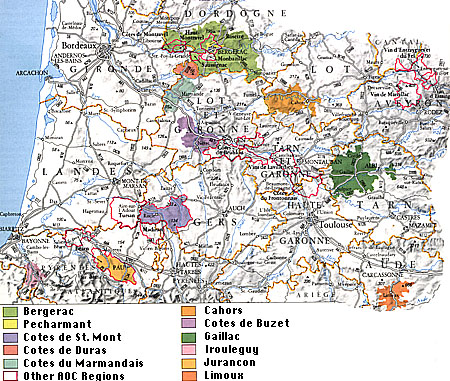
WineRegionsOld WorldFranceOther French Regions
Southwest France
This region comprises many small, scattered areas that combine to produce
a wide range of excellent-value wines with discernible stylistic influences
from Bordeaux, Spain, Languedoc-Roussillon and the Rhone. At the heart of
this region is Gascony, the great brandy district of Armagnac. It was from
here that d'Artagnan set out in 1630 or thereabouts to seek fame and fortune
in the king's Musketeers. The narrow tracks upon which his eventful journey
began still wind their lonely way round wooded hills and across bubbling
brooks. Little has changed since Alexandre Dumas painted such a colorful
picture of these parts, for they remain sparsely populated. Time passes
slowly even in the towns, where the square is usually deserted all day long,
with the exception of the five o'clock rush-hour that can last for all of
ten minutes.
THE DIVERSITY OF THE SOUTHWEST'S APPELLATIONS
The southwest does not have a single wine of truly classic status yet it
probably offers more value for money and is a greater source of hidden bargains
than any other French region. From the succulent, sweet Jurancon moelleux
and Monbazillac, to the fine wines of Bergerac, Buzet and Marmandais, the
revitalized "black wines" of Cahors, the up-and-coming Frontonnais,
the tannic Madiran and the highly individual Irouleguy of the Basque country
this part of France represents tremendous potential for knowing wine drinkers.
Perhaps because it is a collection of diverse areas, rather than one natural
region, the appellations of the southwest at first seem too many and too
confusing. Even within one area there appear to be needless duplications.
In Bergerac, for example, the dry white wines are relatively easy to understand,
there being just two (Bergerac Sec and Montravel), but there are three possibilities
for red wines (Bergerac, Cotes de Bergerac and Pecharmant) and a galaxy
of sweet and semi sweet appellations (Cotes de Bergerac Moelleux, Monbazillac,
Cotes de Montravel, Haut-Montravel, Rosette and Saussignac). No wonder Bordeaux
is such a minefield of confusing minor appellations, when even a comparatively
small area such as Bergerac is so littered with them. It would surely be
simpler to have a single Bergerac appellation to which certain villages
might be allowed to add a communal name; if the same logic were applied
throughout the southwest. more of its wines could achieve marketing success,
rather than attracting occasional attention as hidden bargains.
